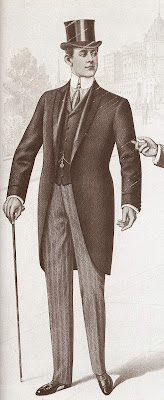I have been intensely working on a project that requires me to study measurement charts and grading charts for children's clothing. It is not the most exciting thing to analyze, I must admit. There has been one size that has been the most difficult to understand and that is the size 9 months for babies.
Traditionally, there never was a size 9 months. The infant size range was arranged:
3M - 6M -
12M - 18M - 24M - 36M
Over time that arrangement dropped the 36M, making the 12M the middle size for sampling and grading. At some point a NB (newborn) and 9M was added. I have not found the reasoning for the additional sizes or exactly when they were added. At least with the NB, it makes some common sense as it is clothing for newly born children. Babies very quickly move through these early infant sizes, so many times the clothes are simple t-shirts and bodysuits. Size 9M, from a measurement standpoint, appears to be a half-size. Something between the 6M and 12M. You could say the 9M should fit a 9 month old baby and perhaps that is the intent.
The problem comes with how to incorporate the size 9M into a normal infant size range offering. It throws off the middle size 12M in sampling and grading. With the addition of the 9M, the 9M becomes the middle size.
NB - 3M - 6M -
9M - 12M - 18M - 24M
No one samples in a size 9M. No one. In fact, it would make grading difficult to do so - just look at the traditional grading charts by Jack Handford.
And that left me wondering. How many brands actually produce a size 9M? While my quick survey is not scientific, it revealed some interesting points.
Manufacturers of sleepwear, t-shirts, bodysuits, or lounge wear, tend to produce only certain sizes and they tend to arrange them:
0-3M, 3-6M, 6-9M
Of course there are variations. Manufacturers of special occasion dresses tend to produce only a few sizes too.
12M - 18M - 24M
There are variations there too. When I worked for a brand that produced christening apparel, we produced all the sizes from NB - 24M. Size 9M was not one of our top selling sizes.
BabyGap does not produce size 9M for any of their styles. They stick to the traditional size range:
3M - 6M - 12M - 18M - 24M
But they arrange their sizes so it looks like they have their bases covered.
Up to 7lb (NB), 0-3M, 3-6M,
6M-12M, 12M-18M, 18M-24M
So what is the point of all this? When you are developing your children's clothing line, you do not need to produce every size. There is a great temptation to offer every style in every size. The reality is that if the big brands aren't doing it, neither do you. A lot depends on the style and your customer. Who do you hang with? Who is your competition? What sizes do they produce? Once you know the answers to those questions, you can focus your efforts.
What about the size 9M? Unless your customer requires that size, it is probably best to skip it or at least make it appear that it is included within a size label like 6M-12M. Some private label programs may require a size 9M. If that is the case, it is a simple matter to split the grade rule between a 6M and a 12M to add the size.





